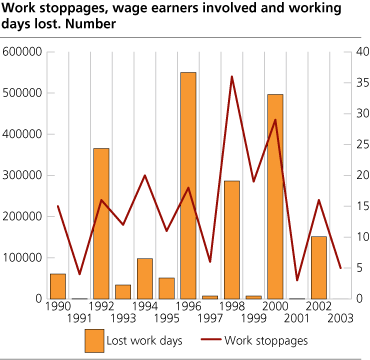Content
Published:
This is an archived release.
1 000 workdays were lost
About 1 000 workdays were lost in connection with labour disputes in 2003. This was 300 days more than in 2001, last time a mid-term settlement took place. By comparison, about 151 000 workdays were lost during 2002, the last year with main settlements.
A total of 95 employees in five labour disputes were affected by disputes in 2003. The oil industry had most of the lost workdays in 2003 with 57 per cent.
As a rule, years with main settlements, such as 2003, have more work stoppages than years with mid-term settlements. The main settlement takes place every other year and means that two-year agreements are signed in most areas. A revision of the agreements entered into during the main settlement takes place in years with mid-term settlements. This explains some of the major changes in the statistics from one year to another.
About the statistical basis
The statistics cover industrial disputes, or work stoppages, of at least one day's duration. The number of disputes per year is computed from the number of trade union federations or confederations that have had groups of employees involved a work stoppage. The following types of strikes are covered: legal strikes, illegal strikes, sympathy strikes, political or protest strikes, general strikes, work stoppages started by employees, rotating strikes. Strikes that are discontinued and later resumed for the same reason count as one strike unless where the interruption lasts more than two months. A dispute resumed after more than two months counts as a new strike. A dispute that occurs one year and continues the next is included in both years, i.e. as two strikes.
The statistics are published annually in DS and Official Statistics of Norway (NOS) Statistical Yearbook.
Tables:
The statistics is now published as Trade union members and strikes.
Additional information
The statistics cover industrial disputes, or work stoppages, of at least one day's duration. The number of disputes per year is calculated based on the number of trade union federations or confederations that have had groups of employees involved in a work stoppage.
Contact
-
Statistics Norway's Information Centre
E-mail: informasjon@ssb.no
tel.: (+47) 21 09 46 42

